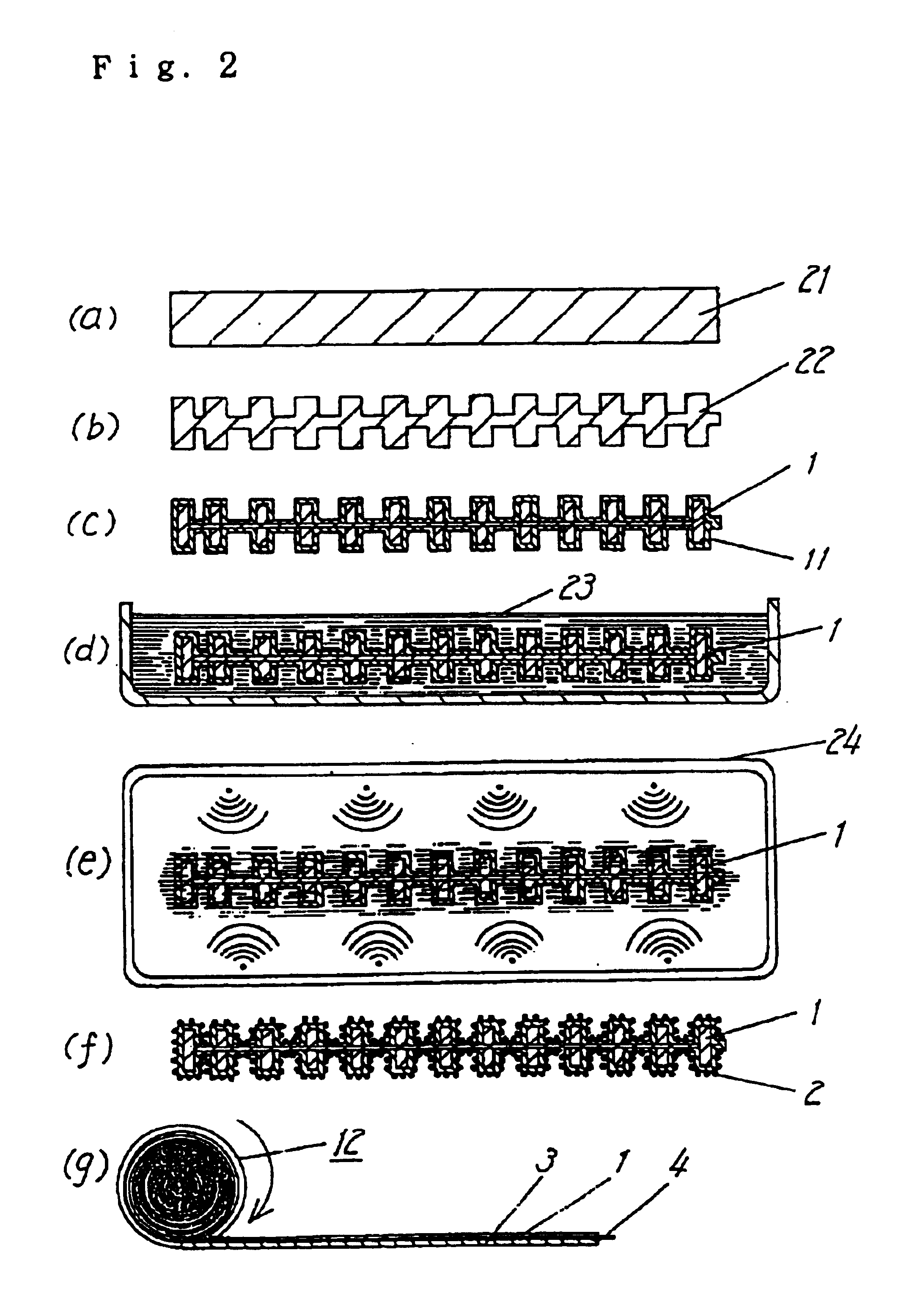Electrolytic capacitor and its manufacturing method
a technology of electrolytic capacitors and manufacturing methods, applied in capacitors, electrolytes/absorbents, capacitor electrolytes, etc., can solve the problems of insufficient effect of lowering resistance, insufficient electric conductivity of separators made conductive by kneading or mixing carbon fibers or particles, and insufficient impedance enhancement of electrolyte, etc., to achieve excellent leak current characteristics, excellent reliability, and excellent impedance characteristics
- Summary
- Abstract
- Description
- Claims
- Application Information
AI Technical Summary
Benefits of technology
Problems solved by technology
Method used
Image
Examples
embodiment 1
[0092](Embodiment 1)
[0093]An anode aluminum foil and a cathode aluminum foil were wound around an electrolytic paper containing Manila hemp fibers (density 0.55 g / cm3, thickness 50 μm). Thus prepared winding type aluminum electrolytic capacitor was kept at temperature of 300° C. for 30 minutes, and the electrolytic paper was carbonized. Then, this capacitor element was immersed in a water-ethanol solution containing ethylene dioxythiophen and ferric sulfate, and lifted, and polymerized (10 minutes at 105° C.), and this process was repeated 10 times. The solid organic conductive material layer composed of polyethylene dioxythiophen thus polymerized chemically was formed on the electrode foils and between electrode foils. Consequently, the capacitor element was washed in water, and dried. Further, electrolyte A was impregnated in this capacitor element. As a result, an aluminum electrolytic capacitor element with rated voltage of 50 V and electrostatic capacity of 390 μF was obtained....
embodiment 2
[0094](Embodiment 2)
[0095]A glass fiber nonwoven cloth (density 0.13 g / cm3, thickness 50 μm), an anode aluminum foil, and a cathode aluminum foil were immersed in a water-ethanol solution containing pyrrole and ammonium persulfate, and lifted, dried and polymerized (10 minutes at 105° C.), and this process was repeated three times. Thus, a chemically polymerized polypyrrole was formed. Then, washing in water and drying, the separator made conductive by the chemically polymerized polypyrrole, and the anode aluminum foil and cathode aluminum foil having the chemically polymerized polypyrrole formed on the surface were obtained. Then, through this conductive separator, the anode aluminum foil and cathode aluminum foil having the chemically polymerized polypyrrole formed on the surface were wound, and a capacitor element was formed. It was further immersed in soluble sulfonated polyaniline solution at concentration of 10 wt. %, impregnated at reduced pressure, lifted, and dried. Thus, t...
embodiment 3
[0096](Embodiment 3)
[0097]On a glass fiber nonwoven cloth (density 0.13 g / cm3, thickness 50 μm), an anode aluminum foil, and a cathode aluminum foil, 7,7,8,8-tetracyanoquinodimethane complex in molten state was applied individually. Then, by cooling, the separator made conductive by the 7,7,8,8-tetracyanoquinodimethane complex, and the anode aluminum foil and cathode aluminum foil having the 7,7,8,8-tetracyanoquinodimethane complex formed on the surface were obtained. Then, through this conductive separator, the anode aluminum foil and cathode aluminum foil having the 7,7,8,8-tetracyanoquinodimethane complex formed on the surface were wound. Thus a capacitor element was formed. It was further immersed in soluble sulfonated polyaniline solution at concentration of 10 wt. %, impregnated at reduced pressure, lifted, and dried at a temperature below the melting point of the 7,7.8,8-tetracyanoquinodimethane complex. Thus, the residual dried sulfonated polyaniline was formed between the a...
PUM
| Property | Measurement | Unit |
|---|---|---|
| rated voltage | aaaaa | aaaaa |
| frequency | aaaaa | aaaaa |
| temperature | aaaaa | aaaaa |
Abstract
Description
Claims
Application Information
 Login to View More
Login to View More - R&D
- Intellectual Property
- Life Sciences
- Materials
- Tech Scout
- Unparalleled Data Quality
- Higher Quality Content
- 60% Fewer Hallucinations
Browse by: Latest US Patents, China's latest patents, Technical Efficacy Thesaurus, Application Domain, Technology Topic, Popular Technical Reports.
© 2025 PatSnap. All rights reserved.Legal|Privacy policy|Modern Slavery Act Transparency Statement|Sitemap|About US| Contact US: help@patsnap.com



